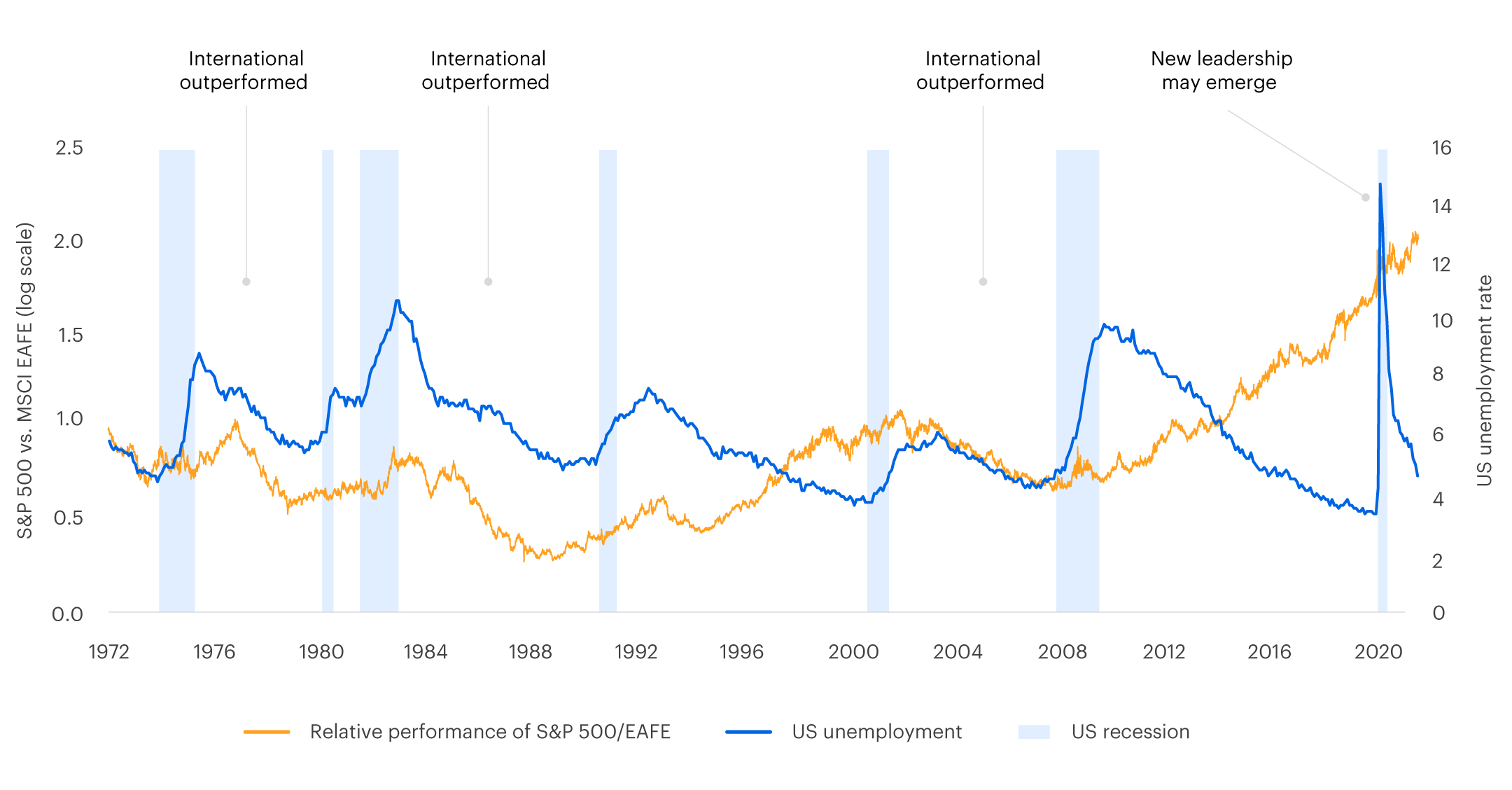The power of global diversification
E*TRADE from Morgan Stanley in collaboration with Morgan Stanley Wealth Management
11/03/21Summary: For investors, international equities can enhance diversification and offer growth potential. In fact, long-term demographic trends may even favor some non-US markets. Explore the different types of international markets and ways to invest.
The US has long dominated the global economy, but as the world becomes more interconnected and developing countries grow in importance, US share of global gross domestic product (GDP) has steadily declined. With more than half of global equity market capitalization outside the US, investors may want to include foreign exposure as part of a diversified portfolio.
More than half of global equity market capitalization falls outside the US

Source: Bloomberg, Morgan Stanley Wealth Management Global Investment Office, as of 10/6/21
Types of international markets
Most markets around the world can be classified into one of three categories that reflect different levels of economic development. For investors, these categorizations reflect differences in market accessibility and liquidity, potential returns, and risk.
- Developed markets are countries with large, advanced economies, like the US, Canada, Germany, and Japan. Generally, these countries have robust infrastructure, political stability, and high per-capita incomes. Developed countries typically have well-established financial systems and liquid capital markets that are accessible to non-domestic investors. Developed market investments tend to be less volatile than emerging markets.
- Emerging markets are countries experiencing considerable economic growth and are often considered on track to become developed markets, such as China, India, and Brazil. These countries may be characterized by growing middle-class populations, moderately developed infrastructure, and less stable political and financial systems than their developed market peers. Emerging market investments can provide exposure to different geographies and can be backed by higher potential growth opportunities than developed economies, although they tend to be less liquid and more volatile.
- Frontier markets are a subset of emerging markets. These countries are in the early stages of economic and/or political development—for example, Serbia, Kenya, and Vietnam—and typically have low per-capita incomes, underdeveloped infrastructure, and weaker regulatory environments. Frontier markets can be among the riskiest non-US investments since they may be associated with smaller companies, markets, and be far less liquid. That said, investors may look to frontier markets for long-term returns, given their potential to become more established over the course of decades.
The case for international investing
Diversifying portfolios across countries and regions can help investors reduce risk and broaden exposure to potential growth opportunities, which may ultimately translate to higher risk-adjusted returns.
Since the 2008 financial crisis, US growth has been relatively strong, boosting corporate profits and US stock prices—which have widely outperformed international peers. Although international corporate profits have lagged those in the US, international stocks trade at less elevated valuations than their US counterparts. Historically, performance leadership has rotated between US and international markets in multi-year spurts; and after a decade-plus of US outperformance, we may be nearing the end of the US-led cycle.
Market leadership tends to rotate at the end of a business cycle

Source: Bloomberg, Bureau of Labor Statistics, Haver Analytics, BEA, Morgan Stanley Wealth Management Global Investment Committee, as of 10/1/21
Additionally, global investors may take advantage of diversification benefits, as US and international equities exhibit lower correlations than US equities alone. In other words, US equities and international equities don’t typically move in lockstep. While US equity indexes are heavily concentrated in the technology sector, other global indexes have more exposure outside tech. For example, compared to the MSCI World Index, the MSCI Europe Index is more heavily weighted in industrials; the MSCI Asia-Pacific Index in consumer discretionary; and the MSCI Canada in financials and energy.
Looking long term, demographic trends may favor emerging markets like China and India. As these countries transition from manufacturing- to consumption-driven economies, there may be greater consumer-led growth opportunities outside of the United States.
Recognizing potential risks
Investing outside the United States does involve additional risks, including currency fluctuations, economic and political factors, and different financial and accounting standards. Keep in mind, investors may not have access to the same information provided by US public companies.
Changes in currency exchange rates can affect returns. Some countries may even have foreign currency controls that prevent or hinder investors or companies from moving currency outside their borders.
International markets may have lower levels of liquidity than US markets, making it harder for investors to buy or sell assets at favorable prices. Also, some countries may have fewer listed companies, reduced market hours, restrictions on the amount of stock international investors can buy, and less financial regulation.
How to invest internationally
Investors can add global exposure to their portfolios in several ways:
- Mutual funds and exchange-traded funds (ETFs): US-registered funds can give investors access to a variety of international holdings through a basket of underlying securities. Some funds target specific regions or countries, such as Europe, Latin America, or Asia.
- US-listed stocks: Some international companies list shares directly on US exchanges. Investors could also gain international exposure through multinational companies based in the United States, but with a significant global footprint.
- American depository receipts (ADRs): ADRs represent shares of international companies that can be traded on US exchanges. Stocks of most non-US companies that trade in the US markets are traded as ADRs.
Investing across sectors, industries, and even geographic locations can enhance portfolio diversification and offer growth potential. As always, though, decisions should align with individual goals, timelines, and risk tolerance.
The source of this article, Power of Global Diversification, was originally published on September 30, 2021.
How can E*TRADE from Morgan Stanley help?
Thematic Investing
Find ETFs that align with your values or with social, economic, and technology trends.
Choice Funds
Choose from a list of exchange-traded funds or mutual funds selected by Morgan Stanley Smith Barney LLC.
Brokerage account
Investing and trading account
Buy and sell stocks, ETFs, mutual funds, options, bonds, and more.